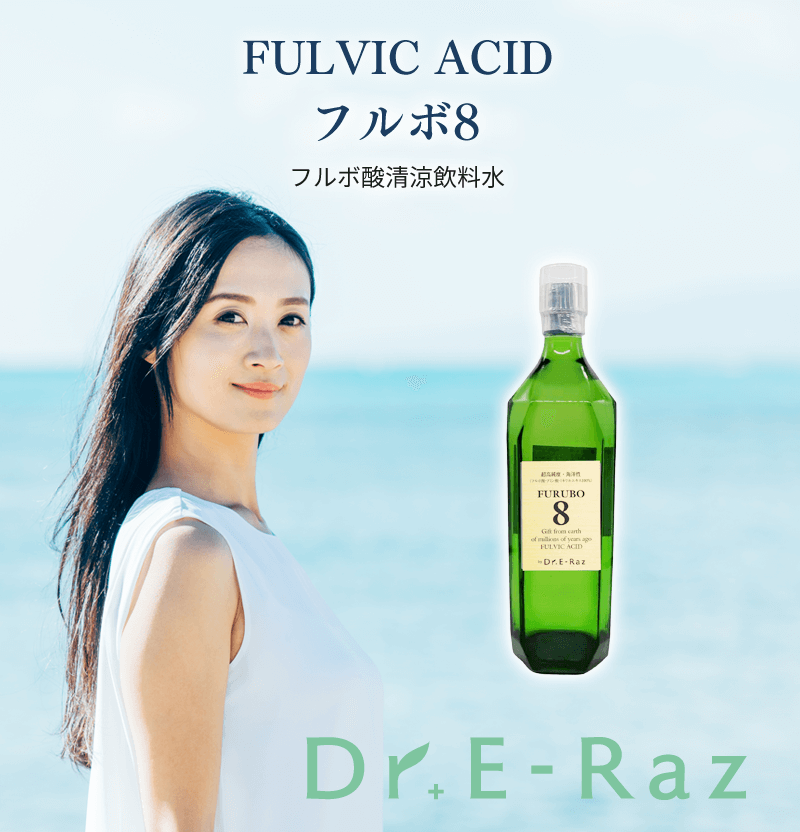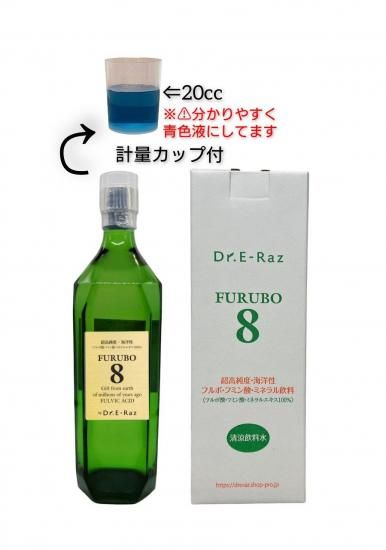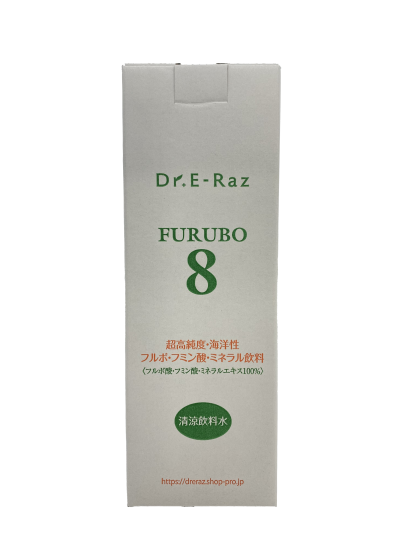


<100% Fulvic Acid, Humic Acid and Minerals Extract>
Marine-derived "Fulvic Acid extract," extracted with advanced technology typically exhibits a "strong acidity" with a pH around 2.8. It contains over 49 different natural components, including 3 types of enzymes, 7 types of vitamins, 22 types of amino acids, 17 types of minerals. The concentration of "Fulvic Acid" is also high, measuring 8.425 ml/L, and it contains a high concentration of humic acid as well, at 5.0 ml/L.
The Maker's Thoughts
Is the fulvic acid you're consuming colorless and transparent? How much does it contain? Is it of marine origin? Is it not used for livestock or agriculture? Is the manufacturing process really okay?
Fulvic acid originally contains heavy metals. Not only are they hard to remove but also they supply negative ions.
After putting in a lot of our effort and conducting extensive research, a product was finally created: FURUBO 8, a crystallization of love!
※For those taking medication, undergoing medical treatment, or pregnant/nursing, please consult with your doctor before consumption.
- Purchases are limited to members only.
- Purchases are limited to one item per person at a time.
- Take advantage of the special offer for a 12-month subscription!
What are required conditions to produce high quality Fulvic Acid extract?
- The soil used as the raw material is free from contamination
- The soil contains a significant amount of Fulvic Acid which is composed of superior quality components
- The soil is free from harmful minerals
- Extracts obtained by artificially decomposing plants are not used, as they may contain chemicals

Our FURUBO 8 meets the conditions for producing high-quality Fulvic Acid
1The soil is free of contamination
The soil used as raw material is from the seabed approximately 5 million years ago, where plants were buried, and through geological shifts, it became terrestrial layers. We extract uncontaminated soil from about 20 meters below the ground.
Therefore, we refer to it as "marine fulvic acid".
2High-quality natural water is used in the purification process
To avoid the reaction between chlorine and fulvic acid, we do not use tap water. We use high-quality natural water and water produced through reverse osmosis membrane in the manufacturing process.
3Testing of chemical substances and harmful minerals is conducted
Rest assured as you enjoy our top-quality Fulvic Acid, free from any harmful chemicals and minerals.
| Product Name | FURUBO 8 (Cooling drink, Unheated process) |
|---|---|
| Active Ingredients | Fulvic Acid 8.425mg/l Humic Acid 5.0mg/l |
| Raw material Name | Water (groundwater) with Humic extract |
| Content | 720ml (approximately 2 months) ※comes with a measuring cup |
| Seller | FLAP Co., Ltd. - Dr.E-Raz Department |
Ingredients
[Natural Enzymes] More than 3 types
- Lipase
- Urease
- Alcohol dehydrogenase
- and Other
[Natural Amino Acids] 22 types
- Aspartic acid
- Alanine
- Arginine
- Isoleucine
- Glycine
- Glutamic acid
- Threonine
- Serine
- Alpha-aminotyrosine
- Beta-aminoisotyrosine
- Beta-alanine
- Gamma-aminotyrosine
- Ornithine
- Valine
- Histidine
- Phenylalanine
- Proline
- Lysine
- Leucine
- Cystathionine
- Hydroxylysine
- Phosphoserine
[Natural Vitamins] 7 types
- Vitamin A
- Vitamin B1
- Vitamin B2
- Vitamin B6
- Vitamin B12
- Vitamin E
- Folic acid
[Natural Minerals] More than 17 types
- Calcium
- Potassium
- Magnesium
- Zinc
- Manganese
- Sodium
- Silicon
- Iron
- Lanthanum
- Strontium
- Aluminum
- Cobalt
- Cerium
- Boron
- Lithium
- Scandium
- Yttrium
- and Other
Preview of Safety Data
Japan Food Analysis Center Foundation
- The test was conducted to determine acute toxicity by oral administration, in accordance with the OECD Guidelines for the Testing of Chemicals (1987).
- The test was conducted to determine transient irritation to the skin, and the result fall within the category of weak irritability".
- The test was conducted to determine irritation to the eyes, and the result fall within the category of non-irritation.
Creative Strategy, Inc.
- The test was conducted to assess irritation with continuous skin exposure, and the result indicates very mild irritation.
- A 48-hour patch test was conducted, and the result indicates no skin irritation.
Tokyo Dental College
- Fibroblast cytotoxicity test result: Clear.
- Corrosion resistance test (surgical blade replacement) result: Clear.
Kumamoto Pharmaceutical Association Drug Inspection Center
- Trihalomethane Generation Test with Mixed Tap Water: Clear.
Frequently Asked Questions
-
FURUBO 8 is a fulvic acid and humic acid beverage which contents 3 types of enzymes (such as Lipase, Urease), 22 types of amino acids (such as Aspartic acid, Alanine), 7 types of natural vitamins (such as Vitamin A, Vitamin B1) and 17 types of natural minerals (such as Canxi, Potassium).
For more details, please refer to “Ingredients” description at the bottom of the Dr.E-Raz homepage. -
We recommend consuming either first thing in the morning before meals, or before going to bed.
※We recommend drinking it directly.
※Please consume 10-20cc per day (use the measuring cup for the accurate measurement.) If you are concerned about the taste, you can dilute it with a little water before drinking.
⚠Do not dilute the beverage with hot water.
⚠This is a high-purity fulvic acid, so please do not mix it with food or any other liquids. Avoid heating it as well. -
"FURUBO 8" is manufactured with the approval for "cooling drink."
“Cooling drink” is a product that has been approved of the safety, and it can be consumed with confidence by people of all ages, from children to the elderly.Please follow the recommended intake and the storage instruction while consuming.
The beverage is produced by pure marine-derived ingredients refined at a super high concentration. Even small amounts can provide efficient nutritional supplementation. -
Yes, they can consume it without any concerns.
-
It contains magnesium so in some cases, people may tend to experience diarrhea throughout consumption.
-
It is plant-based marine properties.
-
Yes, it is safe to individuals with kidney issues.
Our Fulvic Acid has obtained approval of cooling drink, and it contains no additives or preservatives.
It is made from 100% natural, unheated vitamins, minerals, and enzymes. This ensures a high absorption rate and the supply of vital nutrients to the body.※Suggested daily intake is 10cc-20cc (with the provided measuring cup is around 30cc).
-
We are now collecting plant-based marine fulvic acid within Japan.
Worldwide, there are only a few places where fulvic acid is extracted, and the high-quality fulvic acid we use is exceptionally rare.
The quality of fulvic acid can vary depending on the collection site, and if fulvic acid from surface layers, affected by rain and potential contamination by bacteria, viruses, or scientific pollutants, is used, it may not be of the highest quality.
The extraction and production process of fulvic acid requires specific technical expertise, and products generated by companies lacking this expertise may be circulating, requiring caution.Then, what is Fulvic acid?
Fulvic acid is derived from the decomposition of plant residues by microorganisms, resulting in "humic substances".
This substance is soaked in acid to obtain a "non-precipitating amorphous high-molecular-weight organic acid," collectively referred to as fulvic acid.
As a result, the characteristics and composition of fulvic acid vary depending on the "origin" and "raw material”.
By collecting and refining this soil, fulvic acid can be easily obtained in Japan.For example:
In China, fulvic acid-rich decomposed soil (humus soil) is used as agricultural fertilizer.
In North America, fulvic acid is extracted from rocks where plants have fossilized. If used for consumption, careful removal of harmful minerals present in the rocks is necessary.Even in Japan, there are several production areas too.
The content and composition differ in each location where raw materials are collected. -
In Japan, institutions that can examine accurately the content of fulvic acid are:
- Chiba Institute of Technology
- Kobe University, Humic Substances Academic Meeting
Our company's is listed below:
- Fulvic Acid
- Chiba Institute of Technology
- Humic Acid
- Japan Food Analysis Center Foundation
※In addition, when compared to other companies, our company’s accuracy is based on the content amount, not the concentration.
-
Our company takes pride in offering a product of premium purity, 100% ocean derived Fulvic Acid, Humic Acid, and Mineral Extracts. We consider ourselves the best globally in terms of both concentration and content.
Products that use materials close to rocks tend to have higher levels of heavy metals.
This implies a higher likelihood of impurities and harmful heavy metal content.
Additionally, if iron content is high, it may oxidize into iron sediment, causing suspended particles.※Our FURUBO 8 is colorless and transparent, which is a crucial point.
※Content accuracy is more important than concentration.
-
Currently, FURUBO 8 is only available for sale via our online store (this page) and and our physical shop “cafe&bar213”.We are proud to be the KING OF FULVIC ACID - the only authentic product! We are committed to presenting our product’s unique attributes clearly and thoroughly to customers, while simultaneously offering the product for sale.
Please visit our website for more details. -
Currently, we offer payment through credit card, scanning the QR code, and Amazon Pay. You can select a preferred payment option during the purchasing process.
What is FULVIC ACID?
How is the life force of "plants" that sustains our lives and hearts maintained?
Plants combine "photon energy" from the sunlight and "chlorophyll" to produce "starch" from "carbon dioxide" and "water", thus sustaining life.
Animals also maintain their lives by benefiting from this process. When we say "water", it's not just water but also the "nutrients" contained in the soil, which are dissolved in water and absorbed by the roots.
However, "minerals" in the soil and rocks are often mixed with various substances, making it difficult for them to dissolve in water.
How do plants process these minerals to make them easier to absorb, and how do they absorb only the necessary nutrients?
To dissolve "minerals" from the soil and rocks into water, "minerals" must be "ionized" and made to be similar to seawater. It's essential to discharge "negative ions" and transform minerals into "positive ions" to facilitate their absorption by the roots.
"Plants" and "animals" rely on the same "minerals" found in "seawater" as "essential nutrients.
Animals obtain these important ionized minerals by consuming plants that have absorbed them from their roots, thus sustaining life through a deep bond.
However, with the continued use of chemical fertilizers and the mass production of crops on the same land, the soil in fields and farmlands now is lack in minerals. As a result, "plants" and "vegetables" will eventually cease to grow unless they receive an adequate supply of "minerals".
How do "plants" perform the complex tasks of ionizing the "minerals" from the soils and rocks, releasing the "negative ions" and transforming these minerals into easily absorbable" positive ions"?
"Fulvic acid", which is present in the soil, assists with this intricate process.
Plants absorb "fulvic acid” in the soil through their roots, and simultaneously, this "fulvic acid" is also nutrients of the "minerals" from the soil. "Fulvic acid" also plays a role in transporting these nutrients from the roots to the stems and leaves.
The "Fulvic Acid" absorbed by the roots circulates within the plant and is subsequently released from the roots again. It dissolves the "minerals" found in the soil and rocks, detoxifies them, and breaks them down into "positive ions" and "negative ions". Then, it transports them from the roots to the stems and leaves once more.
What exactly is "fulvic acid", which helps with mineral generation, absorption, and transportation?
- With a small molecular weight and a size - a hundred times smaller than a cell, "fulvic acid" can bind with "minerals" and increase their nutrition absorption rate into cells.
- With high redox activity (a reaction where the oxidized substance releases electrons, the reduced substance accepts electrons, and electron transfer occurs simultaneously, leading to a change in properties), trace amounts of "minerals" in “fulvic acid” act as electrodes. They synthesize new "minerals" and transform “harmful effects” such as oxidative lipids (peroxidized lipids), protein denaturation, and DNA damage into "less hazardous effects".
- "Fulvic acid", absorbed by plant roots, "chelates" metallic "minerals" (binding metal ions) with a metallic nature, rendering them in a molecular or ionic state. This process detoxifies and eliminates harmful "minerals", allowing "fulvic acid" to easily move through the "cell walls" and into the cells. "Fulvic acid", whether produced by "plants" or "vegetables" or absorbed by them, plays a vital role in transporting nutrients. When "fulvic acid" enters the body of an "animal", it is turned into an essential nutrient.
"Fulvic acid" detoxifies harmful minerals and substances through redox reactions, further adsorbing them through ion binding and facilitating their removal.
"Fulvic acid" is a vital organic substance found in the roots, stems, leaves of "plants" and "vegetables", as well as in the bodies of "animals" and "humans" who consume them. Regarding harmful components and unwanted "minerals”, it performs essential functions such as:
- Breaking down
- Not absorbing
- Removing
- Detoxifying
Nevertheless, significant environmental changes such as the use of chemical fertilizers, acid rain, exhaust emissions, and the dissolution of chemicals have pushed the natural defense mechanisms of plants to their limits.
Consequently, areas where they cannot defend themselves are expanding day by day.
Ironically, humans who have benefited the most from the protection provided by "plants" against natural dangers, are pushing these "plants" into difficult situations.
Since "fulvic acid" is present within plants but in extremely small amounts, decomposition and fermentation by microorganisms in soil or seabed are used to collect it.
The location (stratum) of collection can be either acidic or alkaline, and its properties vary.
High-quality and safe sources of "fulvic acid" can be found in layers where plants have accumulated over time, remained undisturbed, and were solidified through geological processes. These layers, which were undisturbed by pollution in ancient times, can contain not only "fulvic acid" but also "humic acid", which is rich in enzymes, vitamins, amino acids, and minerals.
Marine-derived "Fulvic Acid Extract", extracted with advanced technology typically exhibits a "strong acidity" with a pH around 2.8. It contains over 49 different natural components, including 3 types of enzymes, 7 types of vitamins, 22 types of amino acids, 17 types of minerals. The concentration of "fulvic acid" is also high, measuring 8.425 ml/L, and it contains a high concentration of humic acid as well, at 5.0 ml/L.
It does not produce trihalomethanes or similar compounds when combined with chlorine.
Typically, the concentration is around 0.02 ml/L, and even in high-quality sources, it may reach up to 0.2 ml/L, which makes marine-derived "Fulvic Acid" relatively pure; however, it is a scarce resource, and extracting it is both time-consuming and it requires advanced technology, making it a costly raw material.
When extracted from rocks or continental strata, larger quantities can be obtained may contain many "harmful minerals" or have a higher risk of forming "trihalomethanes" by reacting with chlorine (e.g., in tap water), making them unsuitable for drinking.










